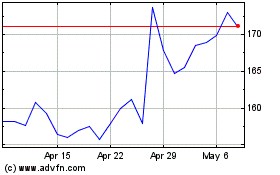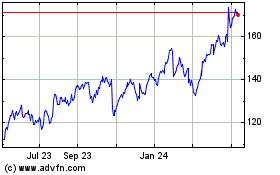By Asa Fitch
Artificial intelligence has mastered some of the world's most
complex games, beating top players at chess, Go and even StarCraft
II, a real-time strategy computer game. But where AI stumbles is in
cracking some of the seemingly simple games, the ones that require
an ability to communicate and collaborate.
That could be about to change. Researchers at Alphabet Inc.'s
Google Brain project and DeepMind unit, which cooked up the AI
programs that defeated humans at Go and StarCraft II, have set
their sights on a new game: Hanabi, a card game in which players
cooperate with one another. Everyone either wins or loses based on
how well they communicate through their play.
If the researchers can figure out how to create a Hanabi master,
that could represent a significant advance for AI, possibly
yielding insights into how machines can interact more fluidly with
humans in contexts such as conversation and autonomous driving, the
researchers involved in this project say. "In everyday life we
don't spend time competing with each other -- we spend time
communicating and cooperating," says Jakob Foerster, a University
of Oxford researcher and a lead author of a paper published in
February announcing the challenge. "Hanabi as a game is all about
communicating and cooperating, and that hasn't been explored" in
the context of AI and games, he says.
Understanding hints
Invented in 2010, Hanabi is played by two to five people who
work together to play cards of five different colors in the right
order. The twist: While all players can see each other's hands,
they can't see their own. To bridge that information gap, players
are allowed to give each other hints about their hands, but they're
limited to naming colors or numbers, leaving players to infer what
cards they should play. They also can only make a limited number of
hints in a given game.
It is that act of communicating efficiently that makes Hanabi
scientifically intriguing. Humans, for example, may naturally
interpret a co-player's hint as an indication that the named card
is playable. But machines won't intrinsically understand such
cues.
"These cooperative games are different and hard because you need
to be able to agree on a way that you're communicating with each
other in order to play the game well, and doing that agreement
requires collaboration among all the players," says Nolan Bard, a
DeepMind researcher working on the challenge and a lead author of
the February paper.
Efforts so far have crafted Hanabi-playing programs that can win
a lot of the time -- but only when they play with other similarly
programmed bots. Having teammates whose playing styles aren't
previously known, or what DeepMind researchers call "ad hoc" play,
is where the researchers see the greatest challenge and the richest
opportunity to find real-world applications
Assumptions and inferences
According to the researchers, humans constantly construct a
"theory of mind" about other people, making the assumption that
others think and act like us and predicting their actions with that
in mind. When someone stands on the street corner, for instance,
drivers assume she is thinking about crossing the road.
Embedding such theories of mind in machines, the researchers
suggest, could improve how autonomous vehicles act when they
encounter new situations, allowing them to grasp what people's
actions mean they're likely trying to do. Robots could be taught,
for example, to understand contextual cues in speech to allow them
to infer what the speaker is thinking.
To illustrate how this kind of capability is currently absent
from AI programs, Dr. Bard uses the example of a computer trained
to play rock/paper/scissors. The computer would throw rock, paper
or scissors an equal number of times and expect to win about half
of the time, Mr. Bard says. But if the human were making the same
play every time, a standard algorithm wouldn't theorize what the
human opponent was thinking and shift strategies to exploit that
tendency. The computer won't realize after 10 times that the human
is always playing rock and it should play paper, he says.
In terms of other games, AI programs for playing bridge have
progressed but still fall short of mastering the game, in part
because of the player skill at communication that is required. Many
forms of poker present a similar problem, where machines struggle
to discern what is implied by players' actions.
Jeff Wu, an engineer at OpenAI in San Francisco, developed a bot
that plays Hanabi using a strategy called "hat guessing," where
card hints are used in complex ways to signal to other players
which of their cards are playable. (The name comes from a popular
logic problem in which a group of people try to guess the colors of
hats on each of their heads.) While Mr. Wu's bot has been a big
success when it is present in all of the players of a game of
Hanabi, he says that developing a theory of mind for Hanabi-playing
bots and for games with unknown co-players is still a huge
challenge.
"With hat guessing, they [the bots] don't have theory of mind --
they have theory of myself and other copies of myself, and that's
good enough if you only play yourself," he says. "If you were to
try to write a bot that really had theory of mind and could try to
figure out what the other agent was thinking and doing, that would
be a lot more challenging."
Researchers working on the Hanabi challenge at DeepMind set up
an open-source platform where people can experiment with artificial
agents and algorithms, but they don't expect the problem's solution
to come soon. Dr. Foerster says he'd be surprised if it only took
five years to master ad hoc play.
Still, Julian Togelius, an associate professor at New York
University who studies AI and games, says games like Hanabi are
fertile ground for innovation. "Game design as it has progressed is
an ongoing mapping of human intellectual ability," he says. "If
there is a form of intelligence, then someone will at some point
design a game that exercises that intelligence."
Mr. Fitch is a reporter in the San Francisco bureau of The Wall
Street Journal. He can be reached at asa.fitch@wsj.com.
(END) Dow Jones Newswires
March 29, 2019 12:17 ET (16:17 GMT)
Copyright (c) 2019 Dow Jones & Company, Inc.
Alphabet (NASDAQ:GOOG)
Historical Stock Chart
From Aug 2024 to Sep 2024

Alphabet (NASDAQ:GOOG)
Historical Stock Chart
From Sep 2023 to Sep 2024
